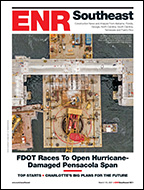Crews filled four big holes in U.S. Highway 136 in northwest Missouri so that drivers wouldn't spend 2½ hours to make what is usually a 10-minute drive from Rock Port, Mo., to Brownville, Neb., said Greg Kaaz, Lexeco president.
Floodwaters tore gaps in the highway, shutting down five miles between the Brownville Bridge and Interstate 29, said Holly L. Hailey, Missouri Dept. of Transportation spokeswoman.
Lexeco had to fill "the Beast," a 480-ft by 65-ft scour hole 65 ft deep, and three other smaller but substantial holes: a 150-ft by 30-ft hole at 40 ft deep, a 75-ft by 10-ft hole at 15 ft deep, and a 300-ft by 25-ft hole at 40 ft deep.
"When MoDOT bid the project, the complete damage hadn't been revealed due to the high water," Kaaz said. But they had some clues because DOT workers had used depth finders to determine damage, so some work started while the road was still underwater.
"Over 115,000 tons of shot rock … was placed in the void areas," Kaaz said, and crews worked 24 hours a day, seven days a week to complete both jobs.
Lexeco crews weren't the only ones on 24/7 duty. Norris Aggregate Products Co., Cameron, Mo., with a quarry 80 miles away, "really stepped up to provide us the material we needed on a tight time frame," keeping the quarry staffed and open around the clock, Kaaz said.
During the project's peak period, between 40 and 70 independent truck drivers hauled rock around the clock after an initial scarcity, caused by a railroad rehab job that also needed rock-hauling trucks.
Lexeco also placed about 2,000 tons of asphaltic concrete, rebuilt shoulders, removed debris, put down traffic striping and installed traffic control devices.
The contractors finished both jobs early. Within 15 days—11 days early—the three smaller holes were filled and the road was back in use; the Beast was filled in 10 days and the work completed in 20 days—12 days early. That gained the company $180,000 in bonuses on bids totaling almost $6.8 million.
The highway isn't only for local travel, Kaaz said. "The economic activity of the area was also threatened since the recently constructed DeBruce Grain Elevator was isolated from rail and truck transportation," he said.





Post a comment to this article
Report Abusive Comment